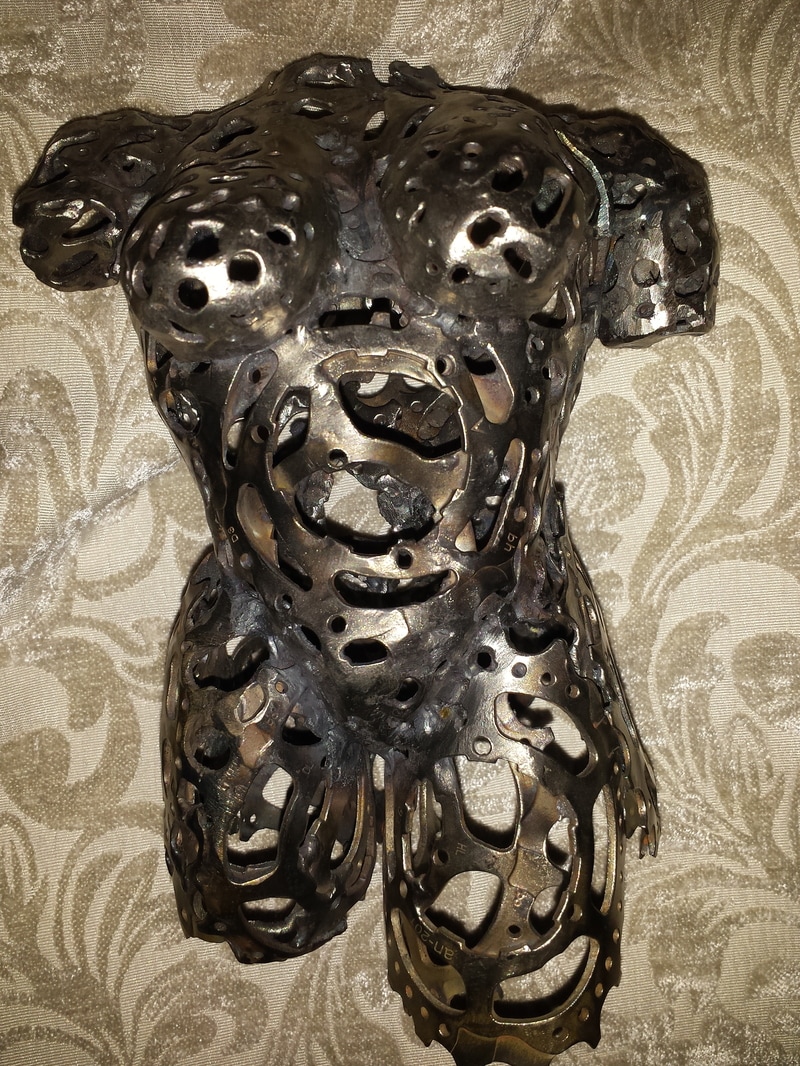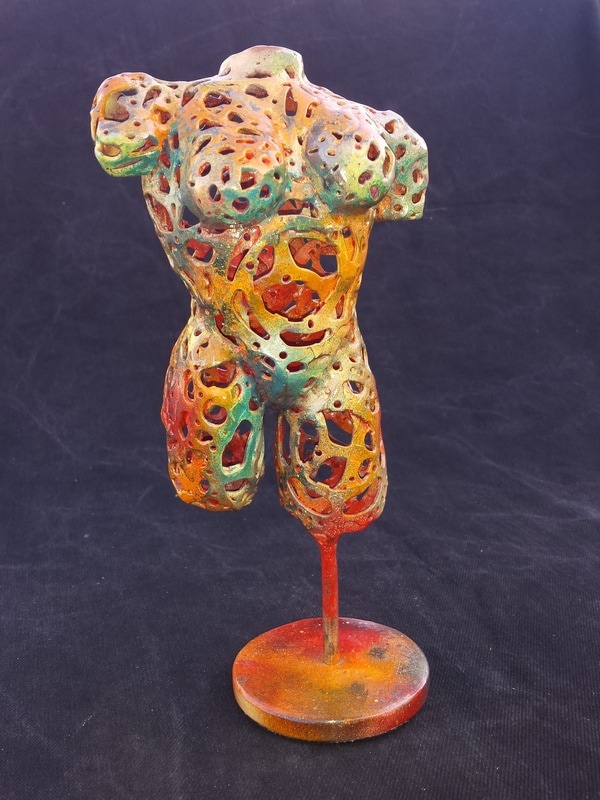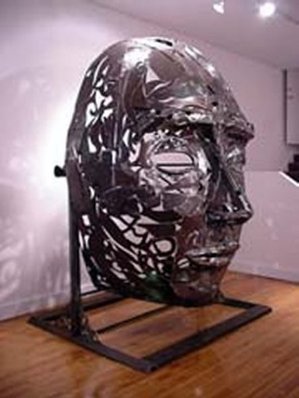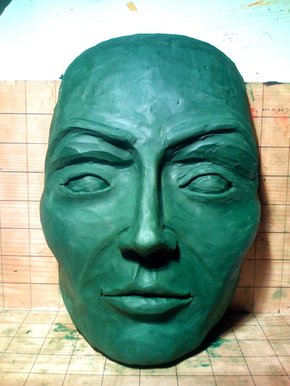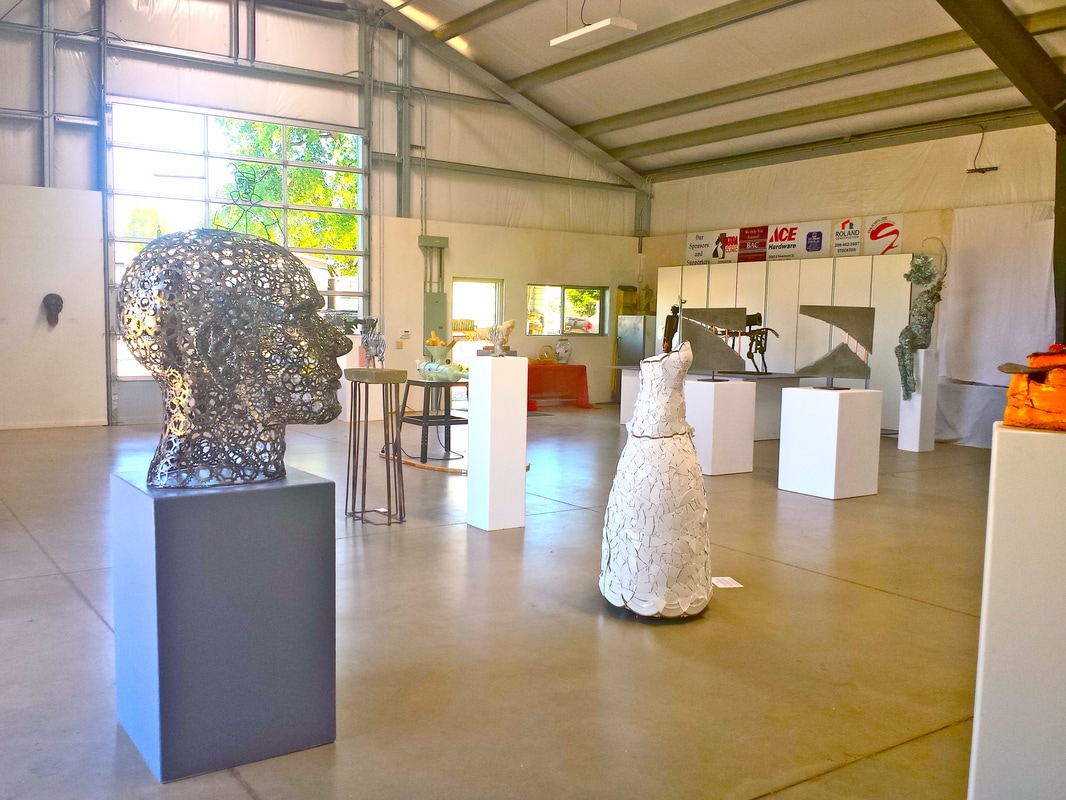|
Since 1992 i have been sculpting welded recycled metals to create figure sculpture. I often passed up the bicycle sprocket when welding the metals together because of its pronounced patterns. Bike gears always seemed to stand out like a sore thumb when mixed into a bunch of other parts. It wasn't until i was confident enough with my direct metal skill-set that i decided to use nothing but the sprockets. that way there would be a uniformity to the overall look and a cohesive integrity to the material parts i was using. The first all bicycle sprocket welded metal sculpture i attempted was of a small horse. Using my usual direct metal welding technique I was able to heat, bend, form, cut and weld the gears in a way that worked. Since then i have launched off on a whole series of small and large welded metal sculptures using exclusively up-cycled bicycle sprockets. Its sort of like Picasso's blue period but its not depressing or blue. Maybe ile paint my next bicycle sprocket sculpture blue and call it Picasso's dream.
0 Comments
Direct metal sculpting is a sculpting process that requires hands on manipulation of metal that directly effects a sculpture form. It involves a combination of different welding, cutting, heating, forming and grinding techniques that create direct results in the sculptures outcome.
Direct metal sculpting is not the lost wax bronze casting sculpture process. In this process the artists create a sculpture usually in clay or wax and then hands it off to a foundry for it to be cast in metal. It is not the assemblage sculpting technique either. This process relies on other means and materials other than welding and metals to create sculptural forms. Welded metals can sometimes be used in this process but it more often strays away from metal to achieve its results.  I usually just work from a printed image when sculpting a figure but sometimes i spend the time to sculpt in clay first. I do this if i think i need more of a 3 dimensional reference. This clay is water based ciln fire clay unfired. If i want to reuse it i just throw it in water and let it get soft again. I prefer to use oil based plastalene clay. This sculpture i titled "Where's my dog?" if you squint your eyes and look at the image on the left you might find the dog. I use different methods for sculpting my large faces. This one process uses an armature or understructure to build a form over. This sculpting technique requires the use of an original form to work on. Most of the time I will have to build the underlying armature first. this form will be modeled to reflect the appearance of the mold that’s sculpted over it. In other words the sculpture i build over the top of the original form will look almost exactly like the original.
Once i have the original all welded together i can then start making a duplicate. In this case here i constructed a 10 ft tall mild steel fece from rusted scrap metal. I then laid the face down facing up and proceeded to weld a stainless steel duplicate over the top of it. I clamped the metal to the original to follow its form tightly and welded it together piece by piece. When it was complete i built a stainless steel frame for the duplicate sculpture to be supported by. Here you can see the original displayed in a NY. Gallery and the stainless steel sculpture duplicate that was made from it. Sorry for the blurry image of the rusted one. For sculpting the large faces I have found that i can sculpt the likeness in clay first. I can then transfer that image to metal. Its a very crude way to transfer an image but it works. you can’t always find the model your looking for so to sculpt it in clay the way you want works well. I sculpt the clay face on a scale of one inch equals one foot. So an 8 inch tall clay face can be built into an 8ft. tall steel face. the face is then sliced vertically. these 1 inch thick slices are placed down on a square grid and the contour is traced. The same is done horizontally. after i have all my contour lines drawn on a grid I draw another grid with 1 ft squares. Then i transfer by eye the 1 inch contour drawings to the 1 ft. graph. I then start laying out and bending 1/4” metal bar to conform to the contour drawings. After all the contour drawings are made in steel bar i weld them together where the horizontal and vertical bars cross and vualla, instant large grid face. Now that i have a rough idea of where the surface is soppesed to lay i can start applying material and making it a solid structure.
This welded steel recycled bicycle sprocket bust sculpture was exhibited at Oakwilde Ranch and Sculpture in 2015. It is titled "Gears Of Thought" and it won best in show that year. Here is that years page, http://oakwilderanchsculpture.com/?page_id=142 Off their website.
This image shows the indoor gallery. The grounds are 50 acres and display many other permanent and traveling artworks. the sculpture park is in Valley Springs California. When I left art school i was focused on sculpting the human figure. The only problem was, i didn't know how to do it or what material to use. I thought about all the different artistic mediums that would allow me to get started.
Clay was real easy to work with but i no access to a kiln and it was to fragile for larger works. Glass is a gorgeous material but aside from being fragile like clay i had no means to the tools let alone the money to get started. Bronze was a definite consideration but once again was cost prohibitive. Wood was ruled out because i didn't have a source or the equipment to gather large blocks of wood let alone a chainsaw to carve with. The only organic material left was steel and i could get that in abundance for free. All i needed was a cheap welder, some basic tools and you can guess what i was doing Christmas day 25 years ago. Recycled Industrial scrap metal as a sculpture medium has been a fantastic and very expressive medium to sculpt with and it is my medium of choice as of today. Here is a half scale horse sculpture. It is an American Saddlebred. I used the same silhouette template from a commissioned horse sculpture but decided to go with very thick recycled metal parts. I intended that this piece could naturaly patina with a rustic look and still last forever out in the ellements. Odviously no surface coating was used in this piece. The beauty here is that the rust can go to town on this piece and it will never look any different. It is also maintenance free.  |
BlogArchives
September 2023
Categories
All
|


